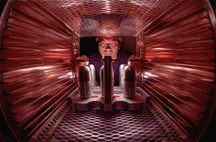On a roll: Building on teamwork, W76 recertification program moves from one success to another
Sandia’s four-year-old W76 Neutron Generator Recertification Program — a key player in DOE’s overall stockpile stewardship effort — has met with such a high degree of recent success that the British hired this diverse Labs group to do the recertification work on the neutron generator assembly in a similar British nuclear weapon. And now, DOE has assigned the program’s team, led by Norm Schwentor (14302), to work on a similar effort for the W78 Minuteman warhead.

Download 150dpi JPEG image, ‘neutron_pix.jpg’, 1 Mb
The W76 program cuts across many organizational boundaries under the overall coordination of Defense Programs Products and Services Division 14000.
Norm says the team’s work has been challenging and rewarding.
"We’re basically making the stockpile better," he says. "We’re contributing to a major upgrading of the stockpile and that’s very satisfying."
The W76 neutron generator assembly is one of the limited-life components (LLCs) in a nuclear weapon that must be recalled periodically for test and reconditioning under DOE’s LLC program.
The W76 recertification program, which moved from Pinellas in Florida to Sandia/New Mexico in 1994 along with all other neutron generator production, got off to a somewhat rocky start. In its early days, Norm says, there was an adversarial, us-against-them attitude, "us" being Sandia and "them" being DOE.
Norm, who came on board the program in 1996 — he’d spent 17 years as a team supervisor in the machine shop — emphasizes the cross-organizational, team-based aspects of the W76 program. He made one big difference early in his new position — he mended fences with DOE and helped steer the program on a track that emphasizes trust-building, cooperation, and customer responsiveness. The program now is on a roll. By incorporating quality processes, the team has reached a level of sustained excellence. "In the last two years," Norm says, "we’ve had 45 consecutive successful Quality Assurance Inspection Procedures (QAIPs) [from DOE]."
The W76 recertification process consists of three stages involving several different organizations across Sandia:
- Stage 1: Disassembly (Dept. 1481-3) — The units are returned from the military as an assembly and are sent to the Explosives Machining Facility in Bldg. 9960, operated by Dept. 1481-3. At this point, the mounting hardware is removed and the timer-driver is separated from the neutron generator. Both units — the generator and the timer-driver — are cleaned and inventoried for traceability in the stockpile. The units are then packaged and sent to bonded stores.
- Stage 2: Recertification and Testing (Depts. 9133, 1481-3, 14302-3) — The neutron generators are drawn from bonded stores. Every generator is X-rayed digitally in Bldg. 860 (Dept. 9133). The units are then moved to Bldg. 842, where they are cleaned and inspected to ensure no damage was done during the separation of the timer-driver. A sample is selected randomly from each group and functionally tested in Bldg. 905 to ensure that neutron output is sufficient and units are operational. Until four months ago the DOE had the recertification program on a Quality Inspection List to inspect and accept the generators at this stage by a QAIP. After successful inspection, the units were DOE diamond-stamped and sent on to Stage 3. This QAIP step, Norm notes, has been eliminated because of the demonstrated high degree of reliability of the processes in Stage 2 and the trust that has been built up with DOE.
- Stage 3: Conversion Process (Dept. 14302-3) — The units are drawn from bonded stores and delivered to Bldg. 905, where the neutron generator is attached to a new timer-driver and marked with the proper identification number and serial number. The units go through a final QAIP. After DOE acceptance, the neutron generator assembly receives the mounting hardware. The units are star-stamped by DOE and returned to the military.
Accompanying each of the three stages is a massive amount of paperwork, required for programs directly involving nuclear weapons components.
Among the centers involved in the W76 recertification program are: 1400, 1500, 1800, 2100, 7800, 9100, 10000, 12000, and 14000.
While offering high praise for every team member for their contributions to the program’s success, Norm singles out two individuals for special mention.
Jim Krupar (2151), Norm says, came with the W76 program from Pinellas, and was instrumental in helping bring Norm up to speed.
"He was a fountain of knowledge," Norm says. "He has a phenomenal memory; he knows the complete history of every neutron generator [in every W76]. He was an incredible asset for me personally and for the overall team effort."
And quality engineer Glenn Roubik (14408), Norm says, helps keep the program on the straight and narrow.
"I’m a ‘keep it simple, stupid’ sort of guy," Norm says. "Glenn is very detail-oriented. He makes sure the program isn’t too simple to be successful. He complicates things, but in an appropriate, good sense."